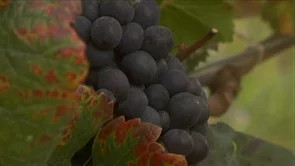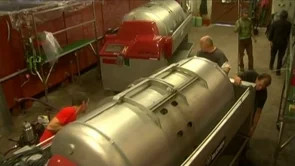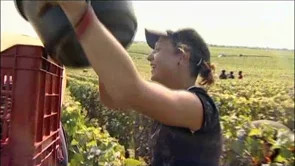-
the history
In the heart of the most prestigious vineyards of Burgundy, we have the good fortune to work climats which have been known throughout the world for centuries... A story of men and women profoundly attached to their terroir, which they seek to reveal and to share through great wines.
JEAN-NICOLAS MÉO -
The "terroirs"
-
When to taste
The best momentAppellationVintage- To find out when to drink your wine, please select an appellation and a vintage.
- Marked by the heat-wave, the wines are powerful, rich and complex, with aromas of dried fruit (figs, raisins, etc.) and a very silky texture. They are ageing very slowly and we recommend that you hold on to them (for the most part, it is premier and grand crus that remain): time must play its role in refining these wines with their flamboyant richness. If you decide, all the same, to open them (some appellations are incomparable with cheese), you will need to air them before tasting.
- A chaotic season, saved by a very pleasant month of September, ended up producing very nice grapes, after sorting, and quite ripe, too. The wines are fine and charming. The green aromas which appeared after bottling have now been largely integrated: ageing has played its role. Today, they are ready to drink.
- The 2005's have very great potential: they are dense and deep, silky and well structured. Unquestionably, a very great vintage, perhaps even the greatest of the last fifty years! If the wines closed down quickly after being bottled, today they are gradually opening up: if you lack patience, why not open a few bottles? It's no longer a crime.
- This is a classic year, very ripe and offering fine balance. The wines are open and charming, even if today, some of them are entering a transitional phase. Very soon after bottling, it was difficult to resist the lower-level wines..., and even the premiers and grands crus! Overall, this vintage is still gaining in strength, but constitutes a good alternative to 2005, which can wait.
- A season which started early but was quite cool produced very elegant and supple wines. These wines were considered to be a little light to start with, but they possess, in fact, a great deal of charm and balance. They continue to taste well, and they will keep, but it appears clear that they have now reached a plateau and are at their optimum.
- The north wind in September did its job: the colours are deep, the fresh-fruit aromas well developed and the composition of the wines is marked by an acidity that appears at the very end of the tasting. Evolution has started to transform the wines: some have reached a beautiful balance, but giving them some oxygen and serving them slightly warm is often a necessity for an optimum presentation.
- A very ripe vintage: around 13.5% ABV, aromas of sweet red fruit, fairly low acidity and great fullness on the palate. As with all great vintages, the terroir will need a little time to reveal itself. Today, some wines are showing a tendency to close up: they are becoming tighter, less direct, not so easy-drinking. A favourable evolution, especially for the premiers and grands crus, which seem to be bound for glory...
- A season that got off to a late start, tiny grapes... Long, precise, elegant, a fresh vintage with a serious finish, it has charmed a lot of people. Some village wines start to loosen up and show what this vintage, so Burgundian in spirit, is capable of. But for most of the wines, patience is still required.
- An early-starting but fresh season; it caused us to fear for the whole of our harvest, but ended up producing very charming wines: very velvety, fresh-black fruit aromas, pleasant colour and a low degree of alcohol. This vintage has a lot going for it. Today, its charm and drinkability are beginning to show up, the vintage begins to be accessible, even if certain wines remain a little tight.
- A difficult season in the vineyards, plagued by severe weather, but finishing with a nice period of sunshine: what a great compensation for our efforts and stress to get a ripe harvest, resulting in delicate wines! The vintage is still a little closed at the moment and with some exceptions, should be left to itself, until the end of its "hibernating" period.
- The 2013 vintage was another nerve-racking one for Burgundy winegrowers. Diseases were present throughout the season, which began with an exceptionally cold and damp month of May, causing a very late harvest. During the flowering in the second half of June, the unsettled weather brought about coulure and millerandage (small berries), and thus a harvest that was 20-25% smaller than usual. These small bunches, however, finally reached perfect ripeness in spite of the mixed summer weather, with the exception of July that was hot and sunny. These diseases made the grapes less sensitive to botrytis, which in the last stormy days before harvest might have wiped out the crop and reduced the proportion of juice. That explains the deep colour of the wines, their natural concentration, without too much tannin, because the partial fertilisation reduced the number and the size of the pips. The late ripening in fairly cool temperatures made it possible to retain intense fruit aromas, the distinctive markers of each terroir, as well as a high level of acidity, the guarantee of long life. This acidity, however, is not noticeable when the wines are tasted, thanks to the very soft tannins and the rich texture which diminish our perception of it. In the end, these wines have turned out to be a magnificent gift from nature. The first people to taste them all agree and stress the tightness, which was to be expected but also, and above all, the preciseness, the fruit, the openness and even the voluptuousness of all these cuvées. They bear witness to the unique character of our region of Burgundy, capable of fashioning wines which are both fresh, ripe and easy-drinking.
Complete table of wines ready to drinkSee the recommendations for tastingTo drink now To drink now or to lay down To lay down
- Domain
- Négoce
Older vintages: all wines to drink now97989900010203040506070809101112131415161718Bourgogne RougeChambolle-MusignyChambolle-Musigny les CrasChambolle-Musigny les FeusselottesClos de VougeotClos Saint-PhilibertCorton Clos RognetCorton La Vigne au SaintCorton Les PerrièresÉchezeauxFixin97989900010203040506070809101112131415161718Fixin Clos du ChapitreGevrey-ChambertinMarsannayMorey Saint-DenisNuits-Saint-GeorgesNuits-Saint-Georges aux ArgillasNuits-Saint-Georges aux BoudotsNuits-Saint-Georges aux MurgersNuits-Saint-Georges les PerrièresRichebourgVosne-RomanéeVosne-Romanée au Cros Parantoux97989900010203040506070809101112131415161718Vosne-Romanée aux BrûléesVosne-Romanée les ChaumesServing temperature
What works best: 16-18°C (61-64°F) for the reds, 12-14°C (54-57°F) for the whites.
Indeed, generally speaking, wines are served too warm ("room temperature” no longer means the same as it did 50 or 100 years ago!).
If you wish to refine this rule of thumb, the following correctives may be applied for the reds: a ripe and warm vintage, such as 2009 or 2012, should be served cool, otherwise the alcohol will dominate; a cool vintage with pronounced acidity should, on the contrary, be warmer (around 20°C or 68°F) so as to give the wine some roundness and not bring out the tannins and the acidity.
Decanting
In general, Burgundies don't need to be completely decanted into a carafe in the way the wines of Bordeaux do, but they ALWAYS need a little airing before being drunk.
The best thing is to open the wine two hours before serving it, to pour oneself a glass so as to smell it (and thus detect any possible problem) and to put the contents of this glass back into the bottle. The emulsion thus created will enable a little air to be introduced into the wine, and this will help greatly to open up the nose and the palate.
It's not really very elegant.., but perfectly efficient and respectful. In some rarer cases, we recommend that you decant and this will be indicated with a pictogram.
Lay down? Or drink straight away?
A few simple rules will be useful in most circumstances:
- young wines offer intense fruit and a brightness which won't be found later on. After bottling, you have 18 to 24 months (so 3 to 4 years after the vintage) to take advantage of that. Then the wine will close up: the aromas will not be so fresh and at the same time, the palate will not have mellowed yet. The worst of both worlds, so to speak.
- for the mouth to become less tart and for the roughness of youth to be polished out while still maintaining good aromatic liveliness, 5 to 7 years on average are required after bottling. So to be more precise and to leave a little leeway, add 7 to 10 years to the vintage. This is the point at which the right balance should be achieved and when all the complexity of the wine should begin to show itself.
- It's impossible to give a drink-by date! As it evolves, the wine's balanced phase may last a very long time. It's for you to see whether you are sensitive to the finesse and the emotion experienced when drinking an old wine.
These simple principles will work in most cases, but you must understand that the adaptations and exceptions are numerous. The less prestigious appellations are normally made to be drunk a little earlier, but a lot of pleasure can be derived with a Bourgogne or a 10-year-old Marsannay. Certain vintages mature more quickly than anticipated (2007) or, on the contrary, require more patience (2010). Certain wines are full of charm when young (Fixin, Chambolle Cras, for example), while others really need to wait to reveal their potential (most of them...). In any case, it's necessary to open the bottles in advance to oxygenate the wine (cf. "Decanting”) and to taste it at the right temperature (cf. "Serving temperature”).
But if wine-lovers are to get to know their own preferences, they must make the effort to acquire experience and self-knowledge, and what's more, these elements will constitute all their pleasure.
-
-
 Meo Camuzet
Meo Camuzet -
 Les vendanges
Les vendanges -
 La vinification
La vinification
The movie
-
-
ContactDomaine Méo-Camuzet
11, rue des Grands Crus
21700 Vosne-Romanée - France+33 3 80 61 55 55